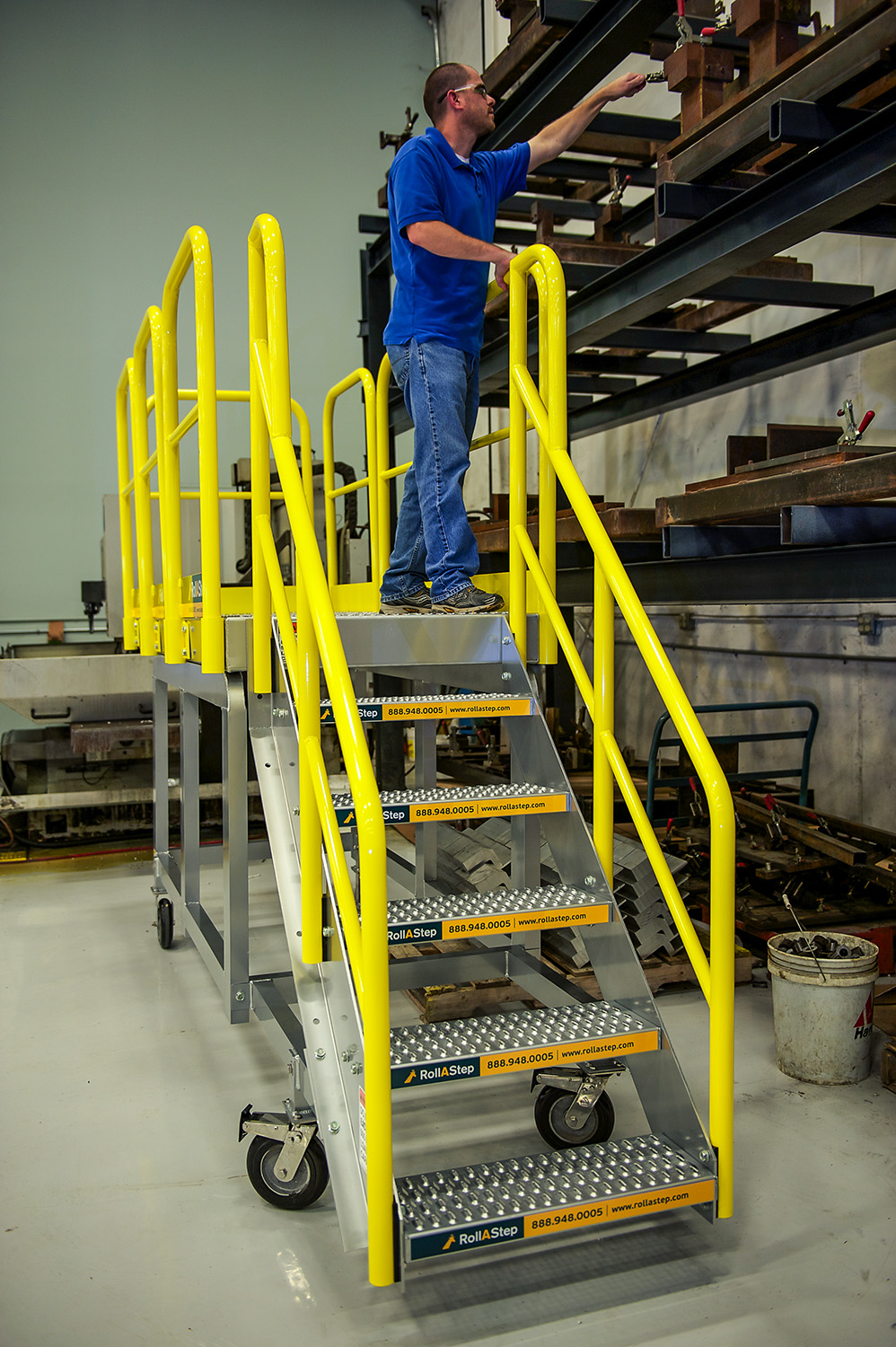Each year, preventable injuries and fatalities occur involving mobile ladder stands and mobile ladder stand platforms. This typically happens when they are not operated according to manufacturers’ instructions and industry safety standards.
Comprehensive workplace safety and health policies and procedures, including safe mobile ladder stand design, training, usage, and inspection, can prevent such incidents.
Design
Used in warehouses, merchandise distribution centers, material storage facilities, and home improvement stores, mobile ladder stands provide safe, elevated work surfaces that can move horizontally across floors on casters or wheels. Manual or automatic position locking mechanisms keep the stands from moving when workers are standing on the surface.
While their design and look can vary depending on actual workplace requirements, these pieces of equipment generally fall into one of two main categories: mobile ladder stands and mobile ladder stand platforms.
- Mobile ladder stands are at a fixed height, self-supporting, and have stairs accessing a top step. They are typically designed for a single standing worker to use while performing tasks like accessing a small item on a shelf or changing a light bulb.
- Mobile ladder stand platforms are larger elevated work surfaces that let multiple workers use the ladder at the same time and space to stage materials and tools. They are generally used to perform manufacturing, assembly, and maintenance tasks.
Safe mobile ladder use starts with choosing the right model for the activity.
Consider the following when choosing an appropriate mobile ladder stand:
- Prevent overreach of the rail during work activity.
- Align the platform size, height, and ladder mobility with the duration, complexity, and/or mobility requirements of the task.
- Make sure the mobile ladder stand’s designed capabilities can handle the maximum intended load (e.g., worker, tools, and materials) of the task at hand.
A mobile ladder stand’s main structural components and use must meet specific OSHA requirements. For additional information, consult appropriate industry standards such as ANSI A14.7.
Training
Before using mobile ladder stands, each worker must be trained in their proper care, inspection, storage, and use, including:
- Position locking mechanisms
- Stair step, handrail, guardrail, and platform use
- Structural component and design requirements
Workers must be re-trained if they are believed to lack the understanding and/or skill required to safely continue using mobile ladder stands. These situations include, but are not limited to:
- Employees performing the job or using equipment in an unsafe manner
- Employers receiving an evaluation or information that workers are not performing the job safely or are involved in an incident or near-miss
This mobile ladder stand and platform safety training video from the American Ladder Institute can help you and your employees put safety first.
Usage
A mobile ladder stand is used in two different ways: as a stationary/immobilized elevated work platform or as a mobile ladder stand that’s moved from position to position. Per OSHA regulations, a mobile ladder stand or platform should never be moved while a worker is on it.
When moving a mobile ladder stand, workers must:
- Ensure it is unoccupied.
- Disengage its locking mechanisms and verify the casters or wheels can move freely.
- Pay close attention to avoid hitting objects, structures, and workers in the area.
When working on a mobile ladder stand, workers must:
- Position it on a smooth, flat surface.
- Engage its locking mechanisms to prevent the stand from moving before stepping onto it.
- Ensure its steps and platforms are slip resistant.
- Keep steps and platforms clean, dry, and free of spills and debris.
- Only use mobile ladder stands for their designed purposes.
- Do not use additional ladders or other objects to increase the working height.
- Do not overreach from the top step or platform.
- Do not stand on handrails, mid-rails, or toeboards to gain additional height.
- Keep both feet firmly on a step or platform.
Note: Additional precautions should be taken when using mobile ladder stands around electrical lines.
Inspection
Mobile ladder inspections should be conducted by qualified personnel according to manufacturer instructions. These inspections, which are vital for identifying structural defects prior to use, should be documented, with each mobile ladder stand displaying a sticker, placard, tag, or log with inspection dates.
In addition to following the manufacturer’s recommended schedule, you must follow OSHA inspection regulations, which call for ladders to be inspected before they are used, for each work shift. If any structural defects are discovered, mobile ladder stands are to be immediately tagged “Dangerous: Do Not Use” and removed from service until they are repaired or replaced.
Source: OSHA Safety and Health Bulletin









